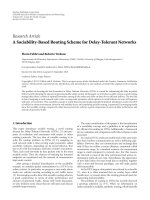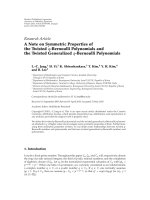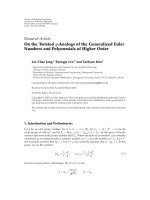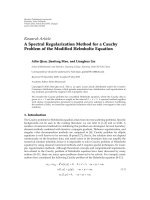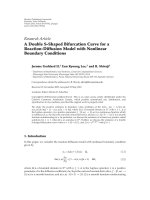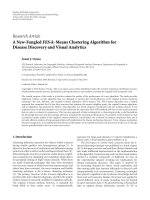Báo cáo sinh học: " Research Article A Contourlet-Based Image Watermarking Scheme with High Resistance to Removal and Geometrical Attacks" pptx
Bạn đang xem bản rút gọn của tài liệu. Xem và tải ngay bản đầy đủ của tài liệu tại đây (8.48 MB, 13 trang )
Hindawi Publishing Corporation
EURASIP Journal on Advances in Signal Processing
Volume 2010, Article ID 540723, 13 pages
doi:10.1155/2010/540723
Research Article
A Contourlet-Based Image Watermarking Scheme with
High Resistance to Removal and Geometrical Attacks
Sirvan Khalighi,
1, 2
Parisa Tirdad,
1
and Hamid R. Rabiee
2
1
Electical and Computer Engineering Department, Islamic Azad University of Qazvin, Iran
2
AICTC Research Center, Department of Computer Engineering, Sharif University of Technology, Iran
Correspondence should be addressed to Sir van Khalighi,
Received 16 August 2009; Revised 8 January 2010; Accepted 1 June 2010
Academic Editor: Yingzi Du
Copyright © 2010 Sirvan Khalighi et al. This is an open access article distributed under the Creative Commons Attribution
License, which permits unrestricted use, distribution, and reproduction in any medium, provided the original work is properly
cited.
We propose a new nonblind multiresolution watermarking method for still images based on the contourlet tr ansform (CT). In
our approach, the watermark is a grayscale image which is embedded into the highest frequency subband of the host image in
its contourlet domain. We demonstrate that in comparison to other methods, this method enables us to embed more amounts of
data into the directional subbands of the host image without degrading its perceptibility. The experimental results show robustness
against several common watermarking attacks such as compression, adding noise, filtering, and geometrical transformations. Since
the proposed approach can embed considerable payload, while providing good perceptual transparency and resistance to many
attacks, it is a suitable algorithm for fingerprinting applications.
1. Introduction
Recent rapid growth of distributed networks such as Inter-
net enables the users and content providers to access,
manipulate, and distribute digital contents in high volumes.
In this situation, there is a strong need for techniques to
protect the copyright of the original data to prevent its
unauthorized duplication. One approach to address this
problem involves adding an invisible structure to a host
media to prove its copyright ownership. These structures
are known as digital watermarks. Digital watermarking is
performed upon various types of digital contents such as
images, audio, text, video, and 3D models. It is applied
to many applications, such as copyright protection, data
authentication, fingerprinting, and data hiding [1]. Current
methods of watermarking images, dep ending on whether
the original image is used during watermark extraction
process or not, could be divided into two categories:
blind and non-blind methods. Schemes reported in [2, 3]
are nonblind methods, while the methods in [4–9]are
categorized as blind methods. Most of the reported schemes
use an additive watermark to the image in the spatial
domain or in frequency domain. Recent works on digital
watermarking for still images are applied on frequency
domain.
Among the transform domain techniques, discrete
wavelet transform-(DWT-) based techniques are more pop-
ular, since DWT has a number of advantages over other
transforms including space-frequency localization, multires-
olution representation, superior HVS modeling, linear com-
plexity, and adaptivity [10]. In general, the DWT algorithms
try to locate regions of high frequency or middle frequency to
embed information, imperceptibly [11]. Even though DWT
is popular, powerful, and familiar among watermarking
techniques, it has its own limitations in capturing the
directional information such as smooth contours and the
directional edges of the image. This problem is addressed by
contourlet transform (CT) [12]. The contourlet transform
was developed as an improvement over wavelet where
the directional information is impor tant. In addition to
multiscale and time-frequency localization proprieties of
wavelets, CT offers directionality and anisotropy.
Zaboli and Moin [2] used the human visual System
characteristics and an entropy-based approach to create an
2 EURASIP Journal on Advances in Signal Processing
efficient watermarking scheme. It decomposes the origi-
nal image in CT domain in four hierarchical levels and
watermarks it with a binary logo image which is scrambled
through a well-known PN sequence. They showed adding a
scrambled watermark to high-pass coefficients in an adaptive
way based on entropy results in a high performance detection
capability for watermark extraction.
Jayalakshmi et al. [3] proposed a non-blind watermark-
ing scheme using the pixels selected from high frequency
coefficients based on directional subband which doubles
at every level. They noted that contourlet-based methods
perform much better than wavelet-based methods in images
like maps. The watermark was a 16
×16 binary logo.
Duan et al. [4] proposed a watermarking algorithm
using nonredundant contourlet transform that exploits the
energy relations between parent and children coefficients.
This special relationship provides energy invariance before
and after the JPEG compression. They embedded a pseudo-
random binary watermark exploiting the modulation of the
energy relations.
Xiao et al. [5] proposed an adaptive watermarking
scheme based on texture and luminance features in the
CT domain, which uses the texture and luminance features
of the host image to find the positions in which the
watermark is embedded. Salahi et al. [ 6]presentedanew
blind spread spectr um method in contourlet domain, where
the watermark is embedded through a PN sequence in the
selected contourlet coefficients of the cover image, and the
data embedding is performed in selected subbands providing
higher resiliency through better spread of spectrum com-
pared to the other subbands.
Shu et al. [7] proposed a blind HVS-based watermarking
algorithm in the translation invariant circular symmetric
contourlet transform. This approach shows good resistance
against Gaussian w hite noise attack. Lian et a l. [8]pre-
sented a method based on nonsampled contourlet transform
(NSCT). The algorithm provides an HVS model in the NSCT
domain, exploiting the masking characteristics of the HVS
to embed the watermark adaptively. Wei et al. [9]presented
an adaptive watermarking method in the CT domain based
on clustering of the mean shift texture features. During
clustering, three texture features including energy, entropy,
and contrast are selected for mean shift fast clustering. The
watermark is directly embedded in the strong texture region
of the host image.
In [13], we proposed a new contourlet-based image
watermarking method which embeds a grayscale watermark
with as much as 25% of the host image size in the
16th directional subband of the host image. Since the
original image is required for watermark extraction, our
method is considered to be nonblind. In this paper, we
employ the method introduced in [13]withmoredetails
and some improvement in our algorithm and provide
comprehensive experiments with more host images. The
remainder of the paper is org anized as follows. In Section 2,
we present Contourlet Transform (CT). In Section 3,we
introduce the proposed approach. Experimental results
are discussed in Section 4. Final remarks are outlined in
Section 5.
Image
LFD
Coarse scale
DFB
Fine scale Directional subba nds
DFB
LPD
(2,2)
···
Figure 1: Contourlet filter bank [6].
a
b
x
−
+
GH
M
M
(a)
a
b
x
−
+
+
G
M
M
H
(b)
Figure 2: Laplacian pyramid scheme (a) analysis and (b) recon-
struction [12].
2. Discrete Contourlet Transform
The contourlet transform (CT) is a geometrical image-
based transform that was introduced in [12]. In contourlet
transform, the laplacian pyramid (LP) is first used to capture
point discontinuities. It is then followed by a directional
filter bank (DFB) to link point discontinuities into linear
structures [14]. As shown in Figure 1, the first stage is LP
decomposition a nd the second stage is DFB decomposition.
The overall result is an image expansion using basic elements
like contour segments, and thus called contourlet transform,
which is implemented by a pyramidal directional filter bank
(PDFB) [15]. At each level, the LP decomposition generates
a downsampled lowpass version of the original, and the
difference between the original and the prediction results in
a bandpass image. Figure 2 illustrates this process, where H
and G are called analysis and synthesis filters, respectively,
and M is the sampling matrix.
The bandpass image obtained in the LP decomposition is
further processed by a DFB. A DFB is designed to capture the
high-frequency content like smooth contours and directional
edges. The DFB is efficiently implemented via a K-level
binary t ree decomposition that leads to 2
K
subbands with
wedge-shaped frequency partitioning as shown in Figure 3.
The contourlet decomposition is illustrated by using the Lena
test image of size 512
×512 and its decomposition into four
levels, in Figure 4. At each successive level, the number of
directional subbands is 2, 4, 8, and 16.
Embedding the watermark in high frequency compo-
nents improves the perceptibility of the watermarked image.
EURASIP Journal on Advances in Signal Processing 3
0
12
3
4
5
6
7
0
12
3
4
5
6
7
(−π, −π)
(π, π)
ω
1
ω
2
Figure 3: Frequency partitioning (k = 3, 2k = 8 we dge-shaped
frequency subbands) [12].
Figure 4: Contourlet decomposition of Lena.
Therefore, we have selected the highest frequency subband
which possesses the maximum energy for watermark embed-
ding (Figure 5). The Energy E of a subband s (i, j), 0
≤ i, j ≤
N is computed by
E
=
i
j
s(i, j)
2
. (1)
The majority of coefficients in the highest frequency
subband are significant values compared to the other sub-
bands of the same level, indicating the presence of directional
edges.
3. The Proposed Approach
We select contourlet transform for watermark embedding
because it captures the directional edges and smooth con-
tours better than other transforms. Since the human visual
system is less sensitive to the edges, embedding the water-
mark in the directional subband improves the perceptibility
of the watermarked image, but it is hardly robust. To
achieve robustness, we can embed the watermark in the
lowpass image of the contourlet decomposition. However,
the perceptibility of the watermarked image degrades. In
1
2
3
4
5
6
7
8
9
10
11
12 13
14 15 16
0
5
2.5
7.5
10
15
×10
5
12.5
Subband
Energy
Figure 5: Energy variation in the last level.
our scheme, although the watermark is embedded into the
highest frequency subbands, it is likely to be spread out
into all subbands when we reconstruct the watermarked
image, due to the special transform structure of laplacian
pyramid (LP) [16]. Because the high-frequency subbands
of the watermarked image contain the watermarking com-
ponents, the proposed scheme is highly robust against
various low-frequency attacks, which will remove the low
frequency component of the image. On the other hand,
some watermarking components can be preserved at the
low-frequency subbands. Thus, the scheme is expected to be
also robust to the high-frequency attacks, which will destroy
the high-frequency components of the image. Consequently,
the proposed watermarking scheme is robust to the widely
spectral attacks resulting from both the low-and high-
frequency processing techniques. The proposed approach is
presented in Section 3.1.
3.1. Watermark Embedding Technique. In the proposed algo-
rithm, the watermark which is a grayscale image, with as
much as 25% of the host image size, is embedded into
the g ray level host image of size N
× N. The host image
and the watermark are transformed into the contourlet
domain.Then, the CT coefficients of the last directional
subband of the host image are modified to embed the
watermark. The steps involved in watermark embedding are
shown in Figure 6.Weuse f (i, j) to denote the host image,
f
(i, j) the watermarked image, and w(i, j) the watermark.
The technique is comprised in three main steps as discussed
below.
Step 1. The host image f (i, j)ofsizeN
× N and the
watermark w(i, j)ofsizeN/2
× N/2 are transformed into the
CT domain. An “n” level pyramidal structure is selected for
LP decomposition. At each level l
k
, there are 2
l
k
directional
subbands, where k
= 1, 2, 3, , n. The highest frequency
subband of the host image is selected for watermark embed-
ding. Watermark decomposition results in two subbands w
1
,
w
2
and a lowpass image. Since w
1
and w
2
have the same
resolution, therefore we choose one of them, in addition to
the lowpass image for watermark embedding.
4 EURASIP Journal on Advances in Signal Processing
Host image Watermark
Compute inverse contourlet transform
Watermarked image
L-level contourlet
transform
L-level contourlet
transform
Modify directional subband coefficients
f
l
k
(i, j) = f
l
k
(i, j)+α·w(i, j)
Figure 6: Embedding algorithm.
Step 2. The coefficients of the selected subband are modified
as follows [17]:
f
l
k
i, j
=
f
l
k
i, j
+ α · W
i, j
,(2)
Where f
l
k
(i, j) represents lth level, kth directional subband
coefficients, and α is a weighting factor which controls
robustness and perceptual quality.
Step 3. inverse contourlet transform (ICT) is applied by
considering the modified directional subbands to obtain the
watermarked image.
3.2. Watermark Extraction Process. For retrieving the water-
mark, we need a copy of the original image as a reference. By
using the inverse embedding formula (3), we can extract the
embedded watermark
w
i, j
=
f
l
k
i, j
− f
l
k
i, j
α
. (3)
The extraction process consists of the following steps.
Step 1. Both watermarked and original images are trans-
formed into CT domain.
Step 2. The directional subband and the lowpass image of
the embedded watermark will be retrieved by subtracting
the highest frequency subbands of the original and the
watermarked image by using (3).
Step 3. For reconstructing the watermark, Laplacian Pyra-
mid requires both directional subbands (W
1
,W
2
) and the
lowpass image (L). Instead of inputting (L,W
1
,W
2
) we input
(L,W
1
,W
1
) into the LP.
Thewatermarkextractionprocessissummarizedin
Figure 7.
By increasing the levels of decomposition, the water-
marking capacity is also increased, and the quality of
Watermarked image
Compute contourlet
coefficients
Original image
Compute contourlet
coefficients
Wate rm ar k
Compute the watermark coefficients
w
(i, j) =
f
l
k
(i, j) − f
l
k
(i, j)
α
Figure 7: Extraction algorithm.
extracted watermark is improved. In order to achieve this
goal, after selecting a subband, we can use other directional
subbands which have the highest level of energy. The water-
marked image quality is measured by the PSNR between f
and f
, formulated by
PSNR
= 10 log
10
255
2
MSE
(
dB
)
,
MSE
=
1
M × N
M
i=1
N
j=1
f (i, j) − f
(i, j)
2
.
(4)
To evaluate the performance of watermar k retrieval
process, normalized correlation (NC) is used. Here, W
1
and W
2
are the original and recovered watermark signals,
respectively. The normalized correlation is calculated by
NC
=
⎛
⎜
⎝
M
i
=0
N
j
=0
W
1
i, j
·
W
2
i, j
M
i
=0
N
j
=0
W
1
i, j
2
·
M
i
=0
N
j
=0
W
2
i, j
2
⎞
⎟
⎠
.
(5)
4. Experimental Results
We have performed experiments w ith various watermarks
and popular host images such as Lena, Barbara, B aboon,
Cameraman, City, Couple, Man, Boat, Elaine, Peppers,
and Zelda of size 512
×512. The watermark is a grayscale
fingerprint (.bmp) of size 128
×128, which contains lots of
curves and significant details. Therefore, it can be a perfect
criterion for measuring the performance of the proposed
method. In addition, it can be used in fingerprinting
applications. In (2), α was set to 0.1 to obtain a t radeoff
between perceptibility and robustness. In both LP and DFB
decomposition, “PKVA” filters [18] were used because of
their efficient implementation. We decomposed the host
image into four levels, and the watermark into one level.
4.1. Watermark Invisibility. Figures 8(a) and 8(b) pro vide
the comparison between the original Lena test image and its
corresponding watermarked image.The original watermark
and the extracted watermark are also shown in Figures 8(c)
EURASIP Journal on Advances in Signal Processing 5
(a) (b)
(c) (d)
Figure 8:(a)Lenaimage.(b)Watermarkedimage.(c)Originalwatermark.(d)Extractedwatermark.
(a) (b) (c) (d)
(e) (f) (g)
Figure 9: Recovered watermarks from Lena image after JPEG2000 compression. (a) Rate = 0.3(b)Rate= 0.4(c)Rate= 0.5(d)Rate = 0.6
(e) Rate
= 0.7(f)Rate = 0.8(g)Rate = 0.9.
6 EURASIP Journal on Advances in Signal Processing
Baboon
Barbara
Boat
Camera
City
Couple
Elaine
Lena
Man
Pepper
Zelda
0.4
0.5
0.6
0.7
0.8
0.9
1
Test images
Normalized correlation
Filtering
Wiener
Soft thresholding
Hard thresholding
Gaussian LPF
FMLR
(a)
Baboon
Barbara
Boat
Camera
City
Couple
Elaine
Lena
Man
Pepper
Zelda
0.4
0.5
0.6
0.7
0.8
0.9
1
Test images
Normalized correlation
Filtering
Wiener
Soft thresholding
Hard thresholding
Gaussian LPF
FMLR
(b)
Figure 10: Normalized correlation results of different test images under different filtering attacks (window size = 3×3) (a) embedding the
watermark in the highest frequency subband of the host image (b) embedding the watermark in the 16th directional subband.
Baboon
Barbara
Boat
Camera
City
Couple
Elaine
Lena
Man
Pepper
Zelda
0.8
0.9
0.82
0.84
0.86
0.88
0.92
0.94
0.96
0.98
1
Test images
Normalized correlation
Image enhancement
Sharpening
Reduce color
Histogram equalization
(a)
Baboon
Barbara
Boat
Camera
City
Couple
Elaine
Lena
Man
Pepper
Zelda
0.8
0.9
0.82
0.84
0.86
0.88
0.92
0.94
0.96
0.98
1
Test images
Normalized correlation
Image enhancement
Sharpening
Reduce color
Histogram equalization
(b)
Figure 11: Normalized correlation results of different test images under image enhancement attacks (a) embedding the watermark in the
highest frequency subband of the host image (b) embedding the watermark in the 16th directional subband.
and 8(d), respectively. The results of embedding data in the
highest frequency subband of the host image are shown in
Table 1 .
Our experiments on the test images showed that the 16th
directional subbands have the highest priority for watermark
embedding. The results of embedding the watermark in the
16th directional subbands of the host images were as follows.
The watermark invisibility can be guaranteed at average
PSNR value of 46.96 dB for all the test images due to their
similar characteristics and the NC value of 0.9862 for all the
extracted watermarks except for the Man image, for which
the PSNR and NC values were 47.09 and 0.9838, respectively.
The results of hiding more amounts of data into the
highest and other directional subbands of the Lena test image
are shown in Tab le 2. The PSNR and NC values for other
subbands are also shown in columns 2 and 3 of the same
table, respectively. We used the 1st and the 4th directional
subbands that have the highest level of energy after the 16th
subband. In addition to embedding the watermark into the
16th directional subband, we hide another version of the
watermark into the 1st and the 4th subband, and thus we
could embed 34 KB of data into the host image without
degrading its perceptual quality. Embedding the watermark
in other subbands with lower energy than a given threshold
EURASIP Journal on Advances in Signal Processing 7
(a) (b) (c) (d)
(e) (f) (g) (h)
Figure 12: Recovered watermarks from Lena image under various filtering and enhancement attacks (a) FMLR, (b) Gaussian LPF, (c) hard
thresholding (d) soft thresholding (e) reduce color (f) image sharpening (g) Wiener filtering (h) histogram equalization.
Baboon
Barbara
Boat
Camera
City
Couple
Elaine
Lena
Man
Pepper
Zelda
0.7
0.8
0.9
0.75
0.85
0.95
1
Test images
Normalized correlation
Noise addition
Gaussian
Poisson
Salt and pepper
Speckle
(a)
Baboon
Barbara
Boat
Camera
City
Couple
Elaine
Lena
Man
Pepper
Zelda
0.75
0.85
0.95
0.8
0.9
1
Test images
Normalized correlation
Noise addition
Gaussian
Poisson
Salt and pepper
Speckle
(b)
Figure 13: Normalized correlation results of different test images under noise attacks (a) embedding the watermark in the highest frequency
subband of the host image (b) embedding the watermark in the 16th directional subband.
will result in perceptual distortion in the watermarked image.
Table 3 shows the results of embedding data in the Lena test
image with different sizes. The size of the watermark is 25%
of the size of the host image.
4.2. Resistance to Various Attacks. It is known that embed-
ding the watermark at the high-frequency subbands of an
image is sensitive to many image processing algorithms
such as lowpass filtering, lossy compression, noise, and
geometrical distortion. On the other hand, the watermark
at low-frequency subbands of an image is sensitive to other
image processing algorithms such as histogram equalization
and cropping. As we mentioned in Section 3, although the
watermark is embedded into the highest frequency subbands,
it is likely to be spread out into all subbands when we
reconstruct the watermarked image, due to the special
8 EURASIP Journal on Advances in Signal Processing
(a) (b) (c) (d)
Figure 14: Recovered watermarks from Lena image after applying different noises (a) Salt and pepper (density = 0.0001) (b) Gaussian noise
(density
= 0.0001) (c) Speckle noise (density = 0.0001) (d) Poisson noise.
Baboon
Barbara
Boat
Camera
City
Couple
Elaine
Lena
Man
Pepper
Zelda
0.55
0.65
0.75
0.85
0.95
0.6
0.7
0.8
0.9
1
Test images
Normalized correlation
Geometric transformations
Cropping
Scaling
Rotation
(a)
Baboon
Barbara
Boat
Camera
City
Couple
Elaine
Lena
Man
Pepper
Zelda
0.65
0.75
0.85
0.95
0.7
0.8
0.9
1
Test images
Normalized correlation
Geometric transformations
Cropping
Scaling
Rotation
(b)
Figure 15: Normalized correlation results of different test images under geometrical attacks: (a) embedding in the highest frequency subband
of the host image (b) embedding the watermark in the 16th directional subband.
Table 1: Results of embedding data in the highest frequency
subband of the host image.
Host image Highest frequency subband PSNR NC
Baboon 13 37.0757 0.986389
Barbara 6 36.7178 0.983328
Boat 4 36.7234 0.985742
Cameraman 1 45.7128 0.987057
City 13 37.0794 0.98637
Couple 13 37.0754 0.986388
Elaine 1 45.7083 0.987072
Lena 16 46.968 0.986253
Man 4 36.9369 0.98061
Peppers 4 36.7585 0.985308
Zelda 4 36.7616 0.985401
transform structure of the Laplacian Pyr amid. In this section,
we attempt to show the robustness of our watermarking
Table 2: Results of embedding more amounts of data into 16th and
another directional subband.
Subband PSNR NC
16&1 43.3194
NC
16
= 0.9596
NC
1
= 0.9852
16&4 36.3084
NC
16
= 0.8954
NC
4
= 0.9858
Table 3: Results of embedding data in Lena image w ith different
size.
Host image size Watermark size PSNR (dB) NC
1024×1024 256×256 (65 KB) 47.1197 0.996708
512
×512 128×128 (17 KB) 46.968 0.986253
256
×256 64×64 (5.05 KB) 36.9065 0.977844
scheme for both high-and low-frequency, signal processing
attacks. The MATLAB 7.0 and Checkmark 1.2 [19]were
EURASIP Journal on Advances in Signal Processing 9
Table 4: Normalized correlation coefficients after JPEG2000 compression on watermarked images in which the watermark is embedded in
the highest frequency subband.
Host 0.3 0.4 0.5 0.6 0.7 0.8 0.9
Baboon 0.907042 0.954985 0.973306 0.978915 0.983985 0.98639 0.98639
Barbara 0.971182 0.977175 0.980079 0.98293 0.983295 0.983295 0.983295
Boat 0.96877 0.976222 0.980652 0.985366 0.985643 0.985643 0.985643
Cameraman 0.983941 0.986697 0.987041 0.987041 0.987041 0.987041 0.987041
City 0.955788 0.973253 0.981524 0.984497 0.986288 0.986288 0.986288
Couple 0.971682 0.980032 0.983572 0.986312 0.986312 0.986312 0.986312
Elaine 0.964434 0.980293 0.984266 0.98591 0.986947 0.986947 0.986947
Lena 0.97721 0.982396 0.985192 0.986252 0.986252 0.986252 0.986252
Man 0.9623 0.971662 0.975141 0.980085 0.980611 0.980611 0.980611
Peppers 0.967675 0.977996 0.982511 0.985192 0.985192 0.985192 0.985192
Zelda 0.977523 0.980563 0.985064 0.985319 0.985319 0.985319 0.985319
Table 5: Normalized correlation coefficients after JPEG2000 compression on watermarked images in which the watermark is embedded in
the 16th directional subband.
Host 0.3 0.4 0.5 0.6 0.7 0.8 0.9
Baboon 0.9407 0.9770 0.9836 0.9854 0.9865 0.9871 0.9871
Barbara 0.9824 0.9846 0.9860 0.9869 0.9871 0.9871 0.9871
Boat 0.9766 0.9841 0.9863 0.9870 0.9872 0.9872 0.9872
Cameraman 0.9850 0.9864 0.9872 0.9872 0.9872 0.9872 0.9872
City 0.9730 0.9837 0.9852 0.9865 0.9872 0.9872 0.9872
Couple 0.9835 0.9849 0.9864 0.9872 0.9872 0.9872 0.9872
Elaine 0.9792 0.9850 0.9861 0.9869 0.9872 0.9872 0.9872
Lena 0.9842 0.9862 0.9869 0.9872 0.9872 0.9872 0.9872
Man 0.9697 0.9798 0.9832 0.9845 0.9848 0.9848 0.9848
Peppers 0.9832 0.9851 0.9864 0.9872 0.9872 0.9872 0.9872
Zelda 0.9840 0.9863 0.9869 0.9871 0.9871 0.9871 0.9871
Table 6: Comparison of the proposed method with other domain
methods.
Characteristic
Proposed
method
Elbasi &
Eskicioglu’s
Method
Wang &
Pearmain
Method
Tran sfor m
domain
Contourlet Wavelet DCT
Watermark type Gray scale PRN sequence Binary
No. watermark
bits embedded
17 KB(128
×128) — 910
PSNR in dB 46.97 40.86 39.21
No. reported
attacks
13 9 4
Extraction type Nonblind Semiblind Blind
used for testing the robustness of the proposed method.
The wide class of existing attacks can be divided into
four main categories: removal attacks, geometrical attacks,
cryptographic attacks, and protocol attacks [ 20]. We inves-
tigate the robustness of our method against removal and
geometrical attacks.
4.2.1. Removal Attacks. Removal attacks aim at the complete
removal of the watermark information from the watermark
data without cracking the security of the watermarking
algorithm [20]. To test the robustness of our method against
removal attacks J PEG2000 compression, image enhance-
ment techniques, various noise, and filtering attacks were
used.
The JPEG2000 attack was tested using Jasper 1.900.1 [21].
Table 4 shows the results of applying JPEG2000 attack on the
watermarked images in which the watermark is embedded
in the highest frequency subband of the host image and
Table 5 shows the results of applying JPEG2000 attack on
watermarked images in which the watermark is embedded
in the 16th directional subband of the host image. The
results demonstrate an excellent robustness of our method
against JPEG2000 compression. Figure 9 shows the extracted
10 EURASIP Journal on Advances in Signal Processing
(a) (b) (c)
(d) (e) (f)
(g)
Figure 16: Recovered watermarks from Lena image under geometric attacks (a) cropping half top (NC = 0.9759) (b) cropping 400×450
(NC
= 0.9398) (c) cropping half right (NC = 0.6697) (d) cropping half left (NC = 0.7260) (e) rotation (angle = 20
o
) (f) scaling (factor = 2)
(g) cropping half down (NC
= 0.1277).
watermarks after compressing Lena image with different
compression rates.
To assess the robustness of the proposed method to
various types of filtering and enhancement techniques, fre-
quency mode Laplacian removal, Gaussian lowpass filtering,
soft thresholding, hard thresholding, wiener filtering, image
sharpening, reduced color, and histogram equalization were
used.
Figures 10 and 11 show the normalized correlation
coefficient results of applying filtering attacks with a 3
×3
window size and image enhancement techniques on different
test images, respectively.
EURASIP Journal on Advances in Signal Processing 11
City Lena Peppers Barbara
0.75
0.85
0.95
0.8
0.9
1
Gaussian noise
Test images
Normalized correlation
Method I
Method II
CEW
Proposed
Figure 17: The robustness comparison result of the proposed
method with [2, 3] under Gaussian attack (mean, var)
= (0,
0.0001).
City
Lena
Peppers
Barbara
0.4
0.5
0.6
0.7
0.8
0.9
1
Cropping
Test images
Normalized correlation
Method I
Method II
CEW
Proposed
Figure 18: The robustness comparison result of the proposed
method with [2, 3] under cropping attack (400
×450).
City Lena Peppers Barbara
0.4
0.5
0.6
0.7
0.8
0.9
0.45
0.55
0.65
0.75
0.85
Rotation
Test images
Normalized correlation
Method I
Method II
CEW
Proposed
Figure 19: The robustness comparison result of the proposed
method with [2, 3] under rotation attack (angle
= 6
◦
).
Table 7: Comparison of the proposed method with similar domain
methods.
Characteristic
Proposed
method
CEW
Method I &
Method II
Watermark type Gr ay scale Binary Binary
No. watermark
bits embedded
17 KB(128
×128) Not mentioned 16×16
PSNR in dB 46.97 Not mentioned ≈47
No. reported
attacks
13 3 3
Extraction type Nonblind Nonblind Nonblind
Figure 12 shows the recovered watermarks of the Lena
test image under these attacks. The results show good
robustness properties of the proposed method against all
the tested attacks except for the thresholding and Wiener
filtering.
To test the robustness of our method under various
noise processes, Gaussian noise, salt & p epper noise, speckle
noise, and Poisson noise with a density of 0.0001 were
used. Figure 13 shows the normalized correlation coefficient
results of applying various noise attacks on different test
images. Figure 14 shows the recovered watermarks of the
Lena test image under different noise processes. Results
demonstrate excellent resistance of our method against
common noises.
4.2.2. Geometrical Attacks. In contrast to removal attacks,
geometrical attacks do not actually remove the embedded
watermark itself but intend to distort the watermark detector
synchronization with the embedded information [20]. The
most common geometrical attacks are rotation, scaling,
and cropping. The parameters used in these attacks are a
rotation angle of 20
◦
, a scaling factor of 2, and cropping
size of 256
× 512 (the top half is removed). Figure 15
illustrates the normalized correlation coefficient results of
these attacks on different test images. Figure 16 shows the
extracted watermarks after applying geomet ric attacks on the
Lena test image. Results of cropping other parts of the Lena
test image are also shown in Figure 16. Results demonstrate
good resistance of our method against cropping and scaling
but poor resistance against rotation attack.
4.3. Compar ison. The performance of the proposed method
was compared with 2 other methods with two different
decomposition types and the results are shown in Table 6.
Wang and Pearmain’s method [22] is a blind watermarking
technique based on the patch work estimation. A total
of 910 watermark bits were embedded in the Lena test
image by using DCT. The PSNR reported was 39.21 dB and
the numbers of attacks reported were only 4. Elbasi and
Eskicioglu’s method [23] is a semiblind DWT watermarking
technique which embeds a pseudorandom number (PRN)
sequence as a watermark in three bands of the image,
using coefficients that are higher than a given threshold.
The reported PSNR was 40.86 dB and the numbers of
12 EURASIP Journal on Advances in Signal Processing
attacks reported were 9. In the proposed method, 17 KB
are embedded and the obtained PSNR is 46.97 dB. The
Watermarked image in our method can survive many attacks,
and it is superior in terms of PSNR compared to these
methods. Furthermore, we compared our method with three
related works, which also used contourlet decomposition.
Method I and Method II are reported in [3], and CEW is
reported in [2]. Tabl e 7 summarizes the comparison results
of the proposed method with these methods. Figures 17,
18 and 19 show the comparison results between Method I,
Method II, CEW, and the proposed method on the popular
test images under the Gaussian noise, cropping, and rotation
attack, respectively. In the Gaussian noise and cropping
attacks, our method outperforms other methods but in
rotation attack (angle
= 6
◦
), the performance of CEW was
better.
5. Conclusion
In this paper, we proposed a new multiresolution water-
marking method using the contourlet transform. In this
method, a grayscale watermark was added to the highest
frequency subband of the host image. The quality of the
watermarked image was good in terms of perceptibility and
PSNR (average of 39.4107 dB) measures. We showed that
wecanembedaremarkableamountofdata(34KB)using
other hig h frequency subbands in addition to the highest
frequency subband. Moreover, we showed that this method
was robust against various removal and geometrical attacks
such as JPEG2000 compression, salt and pepper noise,
Gaussian noise, speckle noise, Poisson noise, frequency
mode Laplacian removal, Gaussian lowpass filtering, reduced
color, image sharpening, cropping, scaling, and histogram
equalization. We compared the robustness of the proposed
method with 3 other contourlet methods under cropping,
Gaussian noise, and rotation attacks. Compared to the
DWT-based and DCT-based methods, the proposed method
is superior in terms of embedding capacity, PSNR and
survival to a number of image attacks. Considering the
good characteristics of our method such as imperceptibility,
robustness and non-blind extraction, it would be a suitable
choice for fingerprinting applications. Our future focus wil l
be on enhancing the robustness properties of the proposed
algorithm against various attacks.
References
[1] J.Cox,M.L.Miller,andJ.A.Bloom,“Watermarkingapplica-
tions and their properties,” in Proceedings of the International
Conference on Information Technology: Coding and Computing
(ITCC ’00), pp. 6–10, Las Vegas, Nev, USA, 2000.
[2] S. Zaboli and M. S. Moin, “CEW: A non-blind adaptive
image watermarking approach based on entropy in contourlet
domain,” in 2007 IEEE International Symposium on Industrial
Electronics, ISIE 2007, pp. 1687–1692, esp, June 2007.
[3] M. Jayalakshmi, S. N. Merchant, and U. B. Desai, “Digital
watermarking in contourlet domain,” in 18th International
Conference on Pattern Recognition, ICPR 2006, pp. 861–864,
chn, August 2006.
[4] G. Duan, A.T. S. Ho, and X. Zhao, “A Novel non-redundant
contourlet transform for robust image watermarking against
non-geometrical and geometrical attacks,” in Proceedings of the
5th International Conference on Visual Informat ion Engineering
(VIE ’08), pp. 124–129, August 2008.
[5] S. Xiao, H. Ling, F. Zou, and Z. Lu, “Adaptive image water-
marking algorithm in contourlet domain,” in 2007 Japan-
China Joint Workshop on Frontier of Computer Science and
Technology, FCST 2007, pp. 125–130, chn, November 2007.
[6] E. Salahi, M. S. Moin, and A. Salahi, “A new visually impercep-
tible and robust image watermarking scheme in Contourlet
domain,” in 2008 4th International Conference on Intelligent
Information Hiding and Multiedia Signal Processing, IIH-MSP
2008, pp. 457–460, chn, August 2008.
[7]Z.Shu,S.Wang,C.Deng,G.Liu,andL.Zhang,“Water-
marking algorithm based on contourlet transform and human
visual model,” in 2008 International Conference on Embedded
Software and Systems, ICESS-08, pp. 348–352, chn, July 2008.
[8] X. Lian, X. Ding, and D. Guo, “Digital watermarking based
on non-sampled contourlet transform,” in 2007 IEEE Interna-
tional Workshop on Anti-counterfeiting, Security, Identification,
ASID, pp. 138–141, chn, April 2007.
[9] F. Wei, T. Ming, and J. Hong-Bing, “An adaptive watermark
scheme based on contourlet transform,” in International Sym-
posium on Computer Science and Computational Technology,
ISCSCT 2008, pp. 677–681, chn, December 2008.
[10] P. Meerwald and A. Uhl, “A survey of wavelet domain
watermarking algorithms,” in Electronic Imaging, Security and
Watermarking of Multimedia Contents, vol. 4314 of Proceedings
of SPIE, January 2001.
[11] D. Kundur and D. Hatzinakos, “Towards robust logo water-
marking using multiresolution image fusion principles,” IEEE
Transactions on Image Processing, vol. 6, no. 1, pp. 185–198,
2004.
[12] M. N. Do and M. Vetterli, “The contourlet transform: An
efficient directional multiresolution image representation,”
IEEE Transactions on Image Processing, vol. 14, no. 12, pp.
2091–2106, 2005.
[13] S. Khalighi, P. Tirdad, and H. R. Rabiee, “A new robust non-
blind digital watermarking scheme in contourlet domain,” in
Proceedings of the 9th IEEE Internat ional Symposium on Signal
Processing and Information Technology (ISSPIT ’09),Ajman
,UAE, December 2009.
[14] D. D Y. Po and M. N. Do, “Directional multiscale modeling
of images using the contourlet transform,” IEEE Transactions
on Image Processing, vol. 15, no. 6, pp. 1610–1620, 2006.
[15] M. N. Do and M. Vetterli, “Pyramidal directional filter
banks and curvelets,” in Proceedings of IEEE International
Conference on Image Processing (ICIP ’01), vol. 3, pp. 158–161,
Thessaloniki, Greece, October 2001.
[16] M. N. Do and M. Vetterli, “Framing pyramids,” IEEE Transac-
tionsonSignalProcessing, vol. 51, no. 9, pp. 2329–2342, 2003.
[17]I.J.Cox,J.Kilian,T.Leighton,andT.G.Shamoon,“Secure
spread spectrum watermarking for multimedia,” in Proceed-
ings of IEEE International Conference on Image Processing
(ICIP ’97), vol. 6, pp. 1673–1687, Santa Barbara, Calif, USA,
October 1997.
[18] S. Phoong, C. W. Kim, P. P. Vaidyanathan, and R. Ansari, “New
class of two-channel biorthogonal filter banks and wavelet
bases,” IEEE Transactions on Signal Processing,vol.43,no.3,
pp. 649–665, 1995.
[19] May 2010, http://watermar king.unige.ch/Checkmark/index
.html.
EURASIP Journal on Advances in Signal Processing 13
[20] S. Voloshynovskiy, S. Pereira, T. Pun, J. J. Eggers, and J. K.
Su, “Attacks on digital watermarks: Classification, estimation-
based attacks, and benchmarks,” IEEE Communications Mag-
azine, vol. 39, no. 8, pp. 118–125, 2001.
[21] May 2010, />∼mdadams/jasper/.
[22] Y. Wang and A. Pearmain, “Blind image data hiding based on
self reference,” Pattern Recognition Letters, vol. 25, no. 15, pp.
1681–1689, 2004.
[23] E. Elbasi and A. M. Eskicioglu, “A DWT-based robust semi-
blind image watermarking algorithm using two bands,” in
Security, Steganography, and Watermarking of Multimedia
Contents VIII, vol. 6072 of Proceedings of SPIE,SanJose,Calif,
USA, January 2006.




